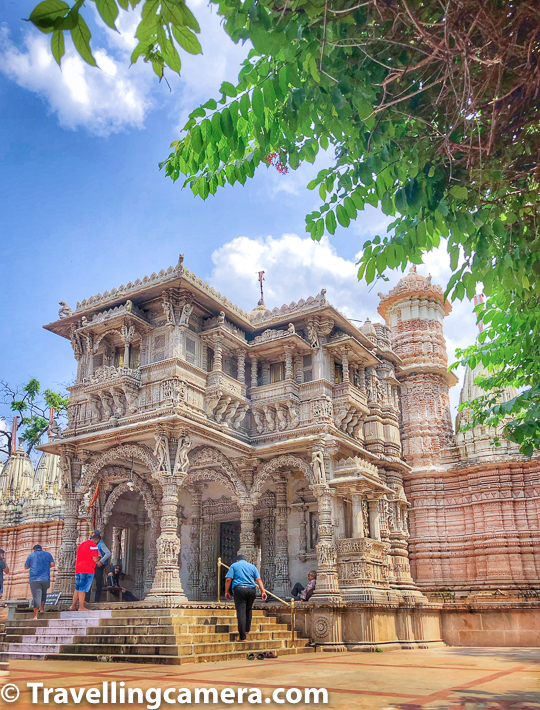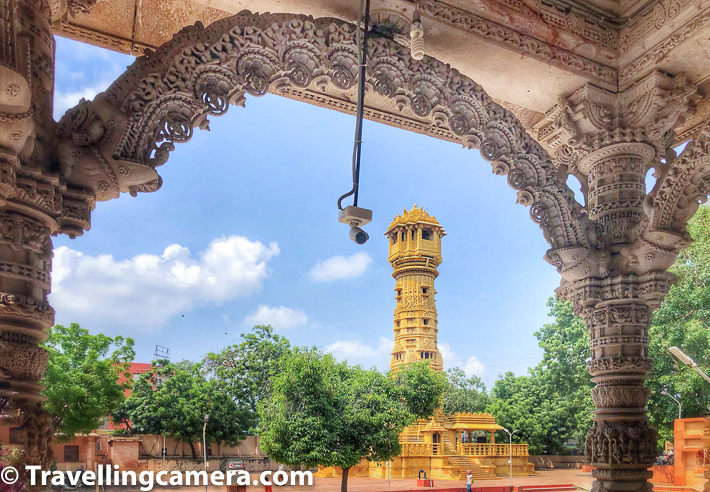After taking the auto out of old Ahmedabad on our first day in Ahmedabad, we headed straight to a Jain Temple that was on the way towards the Sabarmati Ashram. This temple is known as the Hutheesing Jain Temple, and its Manastambha is visible from the road outside. It took us about 10 minutes to reach here in an auto.
The temple was built in the year 1848 and till date stands almost intact and as beautiful. The courtyard is spacious and clean and when we visited the place, it wasn't too crowded. There were a couple of groups of college students who were quite disciplined and respectful of other people. So the place was quite peaceful as well.
The first thing you notice in the temple is an ornate pillar like structure, which is known as the Manastambh (or column of honour) which takes inspiration from the Jain Manastambh and Kirtistambh at Chittore in Rajasthan. This is also the most prominent building in the complex even compared to the temple itself.
The temple itself is quite a beautiful building dedicated to Lord Dharmanatha, the fifteenth Jain Tirthankar. Photography is allowed outside the temple but not inside it, which is unfortunate, because it is really beautiful on the inside. Around a central courtyard, there's a corridor along which various Jain deities have their own spaces. The college students who had also entered the complex while we were there, were inside too silently admiring the architecture and offering prayers. This was quite beautiful to see indeed.
Upon doing some research we found that the architect of the original building was a gentleman known as Premchand Salat. The main temple has two floors and the central figure or the "moolnayak" is a marble statue of the 15th Tirthankara, Lord Dharamnath. The main temple has 11 deities in total, 6 in the basement and 5 elsewhere. The main shrine is on the east. The main temple's roof is a big dome, which is supported by twelve ornate pillars. In the courtyard, there are 52 shrines (devakulikas), each housing an idol of a Tirthankara.
Now for some history. Shet Hathisinh Kesarisinh, a wealthy Ahmedabad trader who died at the young age of 49, initiated the construction of the temple, but did not live to see it completed. His wide Shethani Harkunvar saw it to completion. The total cost came out to be about Rs. 8 Lakh, which meant quite a lot at that time. Today it would amount to several hundred crores of Rupees. The period when the temple was built coincided with a severe famine in Gujarat. The construction of the temple supported the 100s of skilled artisans that were employed here through the period of the drought, which spanned across almost two years. Today the temple is still managed by the Hutheesing family trust. What a legacy to leave behind!
One thing that you need to know before you visit this temple is that you need to be in full-length clothing before you enter the main complex. No shorts or short skirts for anyone. Your legs need to be covered (for both men and women). You can either tie a dupatta around your legs or if you do not have one and happen to be wearing shorts, then there is a gentleman who sits right outside the main temple, from whom you can take a sarong or a dhoti to cover yourself up.
Anyways, from here we decided to head to the Sabarmati Ashram. It was right on the banks of the Sabarmati river and we were looking forward to it. Being near a river sounded really good considering the weather. So we hailed an auto for our onward journey.






.jpg)
Comments